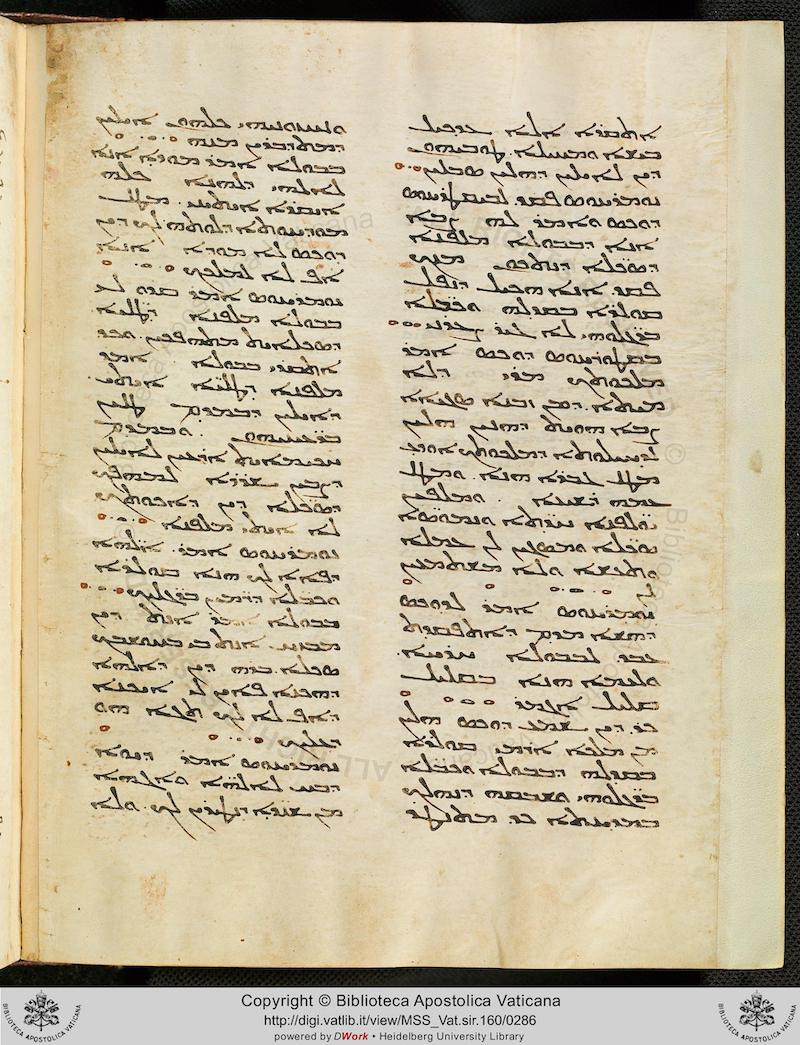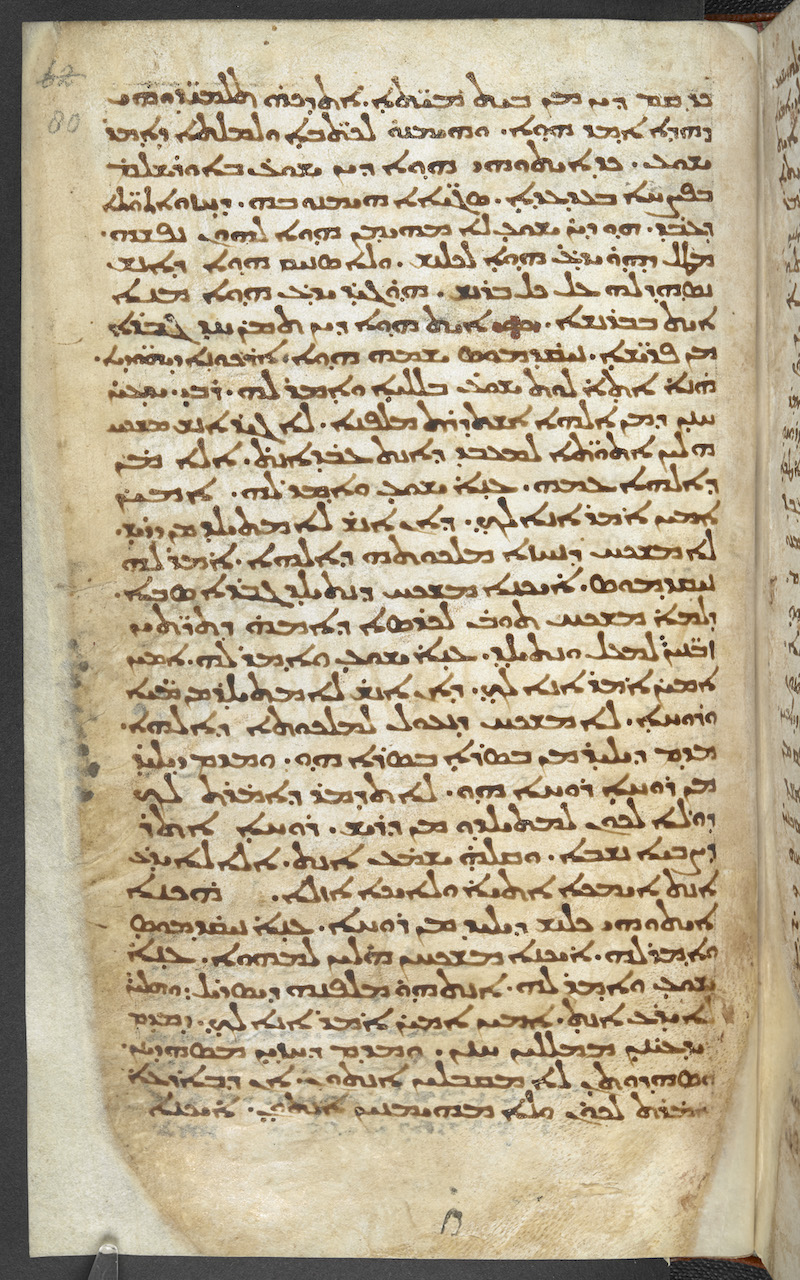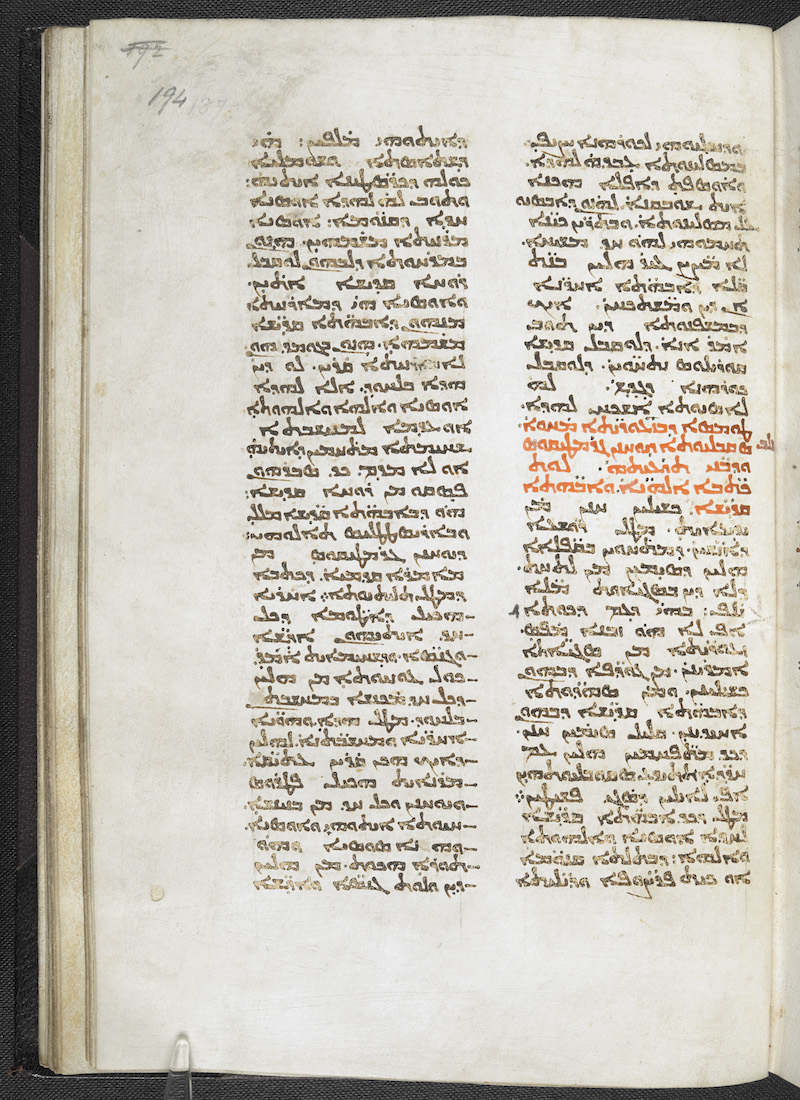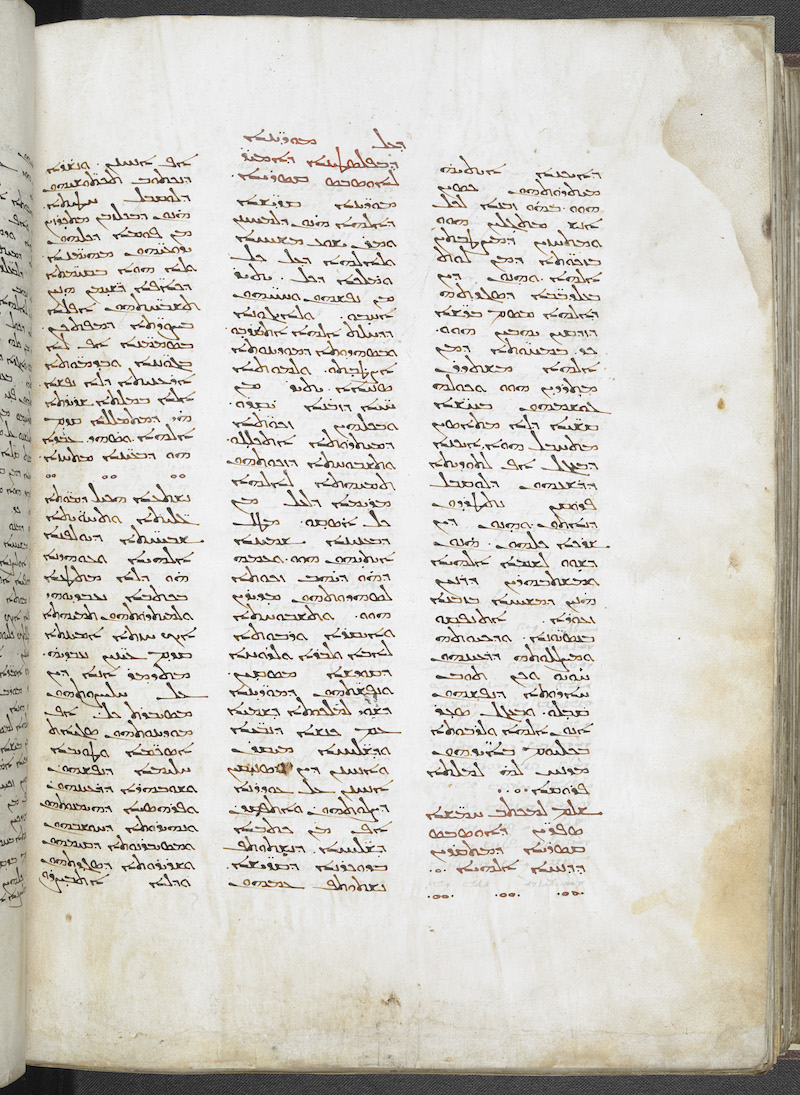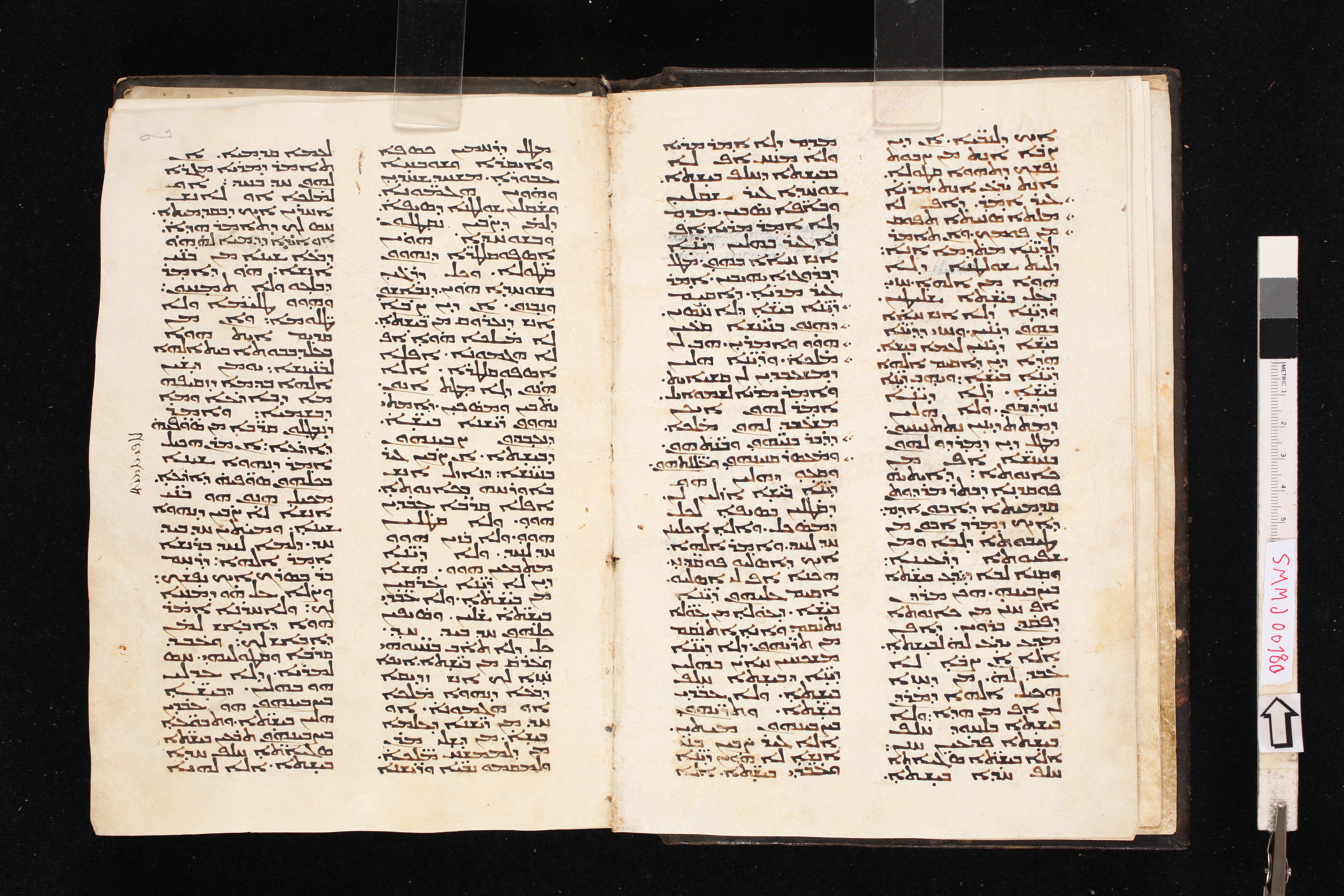
Estrangela, 7th-8th century
-
Title
Book of Steps; Abba Isaiah, Asceticon -
Text
Book of Steps, Mēmrā 22, in Patrologia Syriaca 3, col. 649.19-653.9. -
Language(s)
Syriac -
Writing System
Syriac -
Script(s)
Estrangela -
Country
Jerusalem -
City
Jerusalem -
Repository
Saint Mark's Monastery -
Shelf Mark
SMMJ 180, fol. 26v -
Century
7th-8th century -
Year Range
600-800 -
Provenance
Fol. 102r: note dated 1881 that the book was repaired by Grigorios Ǧirǧis Muṭrān of Jerusalem -
Bibliography
René Draguet, Les cinq recensions de l’Ascéticon syriaque d’Abba Isaïe, CSCO 289 / Scr. Syr. 120 (1968)
Grigory Kessel, “A Previously Unknown Reattributed Fragment from Memra 16 of the Book of Steps,” in Kristian S. Heal and Robert A. Kitchen, eds., Breaking the Mind: New Studies in the Syriac “Book of Steps“ (2014), p. 53-71, esp. 54-60. The volume has a picture from this manuscript on its cover.
Michael Kmoskó, Liber Graduum, Patrologia Syriaca 3 (1926).
-
External Facsimile
111 leaves, on parchment. 2 columns, 39 lines per column; support dimensions 25.6 x 17.5 cm. Misbound.
Acknowledgements: Described by Adam McCollum
Transcription
The lines have been numbered, and marginalia are indicated with \\ //.
Col. a
01 ܥܡܐ ܕܠܐ ܬ̇ܝܟܝܢ ܡܢ
02 ܒܝܫܬܐ ܘܐܟ̇ܠܝܢ ܚܕ
03 ܠܚܕ݂. ܗܠܝܢ ܕ̈ܝ̇ܢܐ ܚܫܚܝܢ.
04 ܘܠܗܘ̇ ܬܒܘܥܐ̇ ܕܒܝܫ̈ܬܐ
05 ܪܚ̇ܡ ܕܢܗܘܐ ܬ̇ܒܥ܉ ܬܘܒ
06 ܥܡܐ ܕܒܝܫ ܡܢ ܗܢܐ̇
07 //ܙܕܩ\\ ܐ̇ܙܠ ܠܗ݂. ܡܛܠ ܕܥܠ ܒܝܫܬܐ
08 ܗܘ ܡܬܬܢܝܚ. ܡܛܠܗܢܐ
09 ܟܕ ܚ̣ܙܐ ܐܠܗܐ ܕܗܟܢ
10 ܐܢܘܢ ܒܢܝ̈ܢܫܐ܃ ܕܐܦ ܠܐ
11 ܒܝܫ̣ܬܐ ܚܠܦ ܒܝܫ̣ܬܐ
12 ܒܠܚܘܕ ܦܪܥ̇ܝܢ ܚܕ ܠܚܕ܄
13 ܠܐ ܥܡܐ ܐܦ ܠܐ
14 ܕܝܢ̇ܘ̈ܗܝ܉ ܟܬ̣ܒ ܘܚ̇ܘܝ
15 ܠܗܘܢ܉ ܕܒܝܫ̣ܬܐ ܚܕܐ ܚܠܦ
16 ܒܝܫ̣ܬܐ܇ ܢܦ̇ܪܥܘܢ ܒܗ̇ܘ
17 ܢܡܘܣܐ ܩܕܡܝܐ. ܐܝܟ
18 ܕܐܡ̣ܪ܇ ܕܣ̇ܡܬ ܠܗܘܢ
19 ܕܝ̈ܢ̣ܐ ܕܠܐ ܐܢܫ ܚ̇ܐܐ
20 ܒܗܘܢ. ܐܢܫܐ ܠܡ ܒܝ̈ܫܐ
21 ܝܗ̇ܒܬ ܠܗܘܢ ܦܘܩܕ̈ܢܐ
22 ܕܠܐ ܫܦܝܪ̈ܝ̣ܢ܉ ܘܕܝ̈ܢ̣ܐ ܕܠܐ
23 ܢܚ̣ܘܢ ܒܗܘܢ. ܐܝܟ ܠܡ
24 ܡܕܡ ܕܗ̣ܢܘܢ ܨܒ̣ܘ. ܗܢܘ
25 ܕܝܢ ܠܡ܉ ܥܠ ܕܐܪܦܝܘ
26 ܦܘܩ̈ܕܢܐ ܫܦܝܪ̈ܐ ܕܚܘܒܐ܇
27 ܗ̇ܢܘܢ ܕܟܠܗ ܚܝܠܐ
28 ܕܢܡܘܣܐ ܘܕ̈ܢܒܝܐ
29 ܡܫܬ̇ܠܡ ܗܘܐ ܒܗܘܢ܇
30 ܗ̇ܢܘܢ ܕܪܚܡ ܠܐܠܗܐ ܘܠܒܪ
31 ܒܣܪܟ܇ ܕܐܠܘ ܩܡ̣ܢ
32 ܒܗܘܢ ܐܘ ܚܢܢ ܐܘ
33 ܗܢ̣ܘܢ܇ ܟܒܪ ܕܝܢ ܚܒ
34 ܣܛܢܐ. ܒܒܪܢܫܐ ܗܘ ܓܝܪ
35 ܚ̇ܛܐ ܐܢܫ܉ ܘܒܒܪ ܐܢܫܐ
36 ܗܘ ܡܙܕܕܩ. ܪܚ̣ܡܘ ܠܡ
37 ܩܛܠܐ ܘܒܥܠܕܒܒܘܬܐ̣
38 ܘܣܢܐܬܐ ܟܣܝܬܐ. ܡܛܠ
39 ܗܢܐ ܝܗ̇ܒܬ ܠܗܘܢ
40 ܦܘܩ̈ܕܢܐ܉ ܕܡܐ ܕܢܛܪ̣ܘ
Col. b
01 ܐܢܘܢ̣ ܢܡܘܬܘܢ. ܐܢ
02 ܬܗܠܟܘܢ ܥܡܝ ܒܩܪܚܘܬܐ܉
03 ܩܪܝܐܝܬ ܐ̇ܗܠܟ ܥܡܟܘܢ.
04 ܘܬܘܒ݂ ܐܡ̣ܪ. ܪܚ̣ܡܘ
05 ܠܘ̈ܛܬܐ̣ ܘܠܐ ܨܒ̣ܘ
06 ܒܒܘܪ̈ܟܬܐ. ܡܛܘܠ
07 ܕܐܣܠܝܘ ܒܘܪ̈ܟܬܐ ܕܡ̣̈ܠܝܟܝܢ
08 ܠܗ̇ܢܘܢ ܕܪܕܝܢ ܒܟܐܢܘܬܐ܇
09 ܗܝ̇ ܕܠܐ ܡܒܐܫܐ
10 ܠܐܢܫ܇ ܐܠܐ ܢܛܪܐ
11 ܢܦܫܗ̇ ܡܢ ܒܝ̈ܫ̣ܬܐ̇܉
12 ܘܥܪܩܐ ܡܢ ܕܝ̈ܢ̣ܐ܇
13 ܘܕܚܠܐ ܕܬܡܠܠ ܩܫܝܐܝܬ̣
14 ܕܠܐ ܢܚ̇ܝܒܗ̇܇ ܘܐܢ ܓ̣ܕܫ
15 ܘܡܚܐ ܠܗ̇ ܐܢܫ̣
16 ܡܣܝܒܪܐ܇ ܘܡܪܢ ܕܐ̇ܢ
17 ܕܝ̇ܢ݂ܗ܇ ܠܝܬ ܠܗ ܓܝܪ ܦܘܪܣܐ܇
18 ܠܡ̇ܢ ܕܡ̇ܗܠܟ ܒܟܐܢܘܬܐ
19 ܐܘ ܒܚܘܒܐ ܐܘ
20 ܒܓܡܝܪܘܬܐ܇ ܕܢܬܒ̣ܥ
21 ܢܦܫܗ ܡܢ ܡ̇ܢ ܕܬ̇ܒܥ
22 ܠܗ ܒܩܛܝܪܐ܇ ܐܠܐ ܐܢ
23 ܬܒܥܗ ܡܪܢ܇ ܘܐܝܬܝ
24 ܥܠܘܗܝ ܐܘܠܨܢܐ ܩܫܝܐ
25 ܥܕܡܐ ܕܡܬ̇ܡܟܟ. ܡܛܠ
26 ܗܟܝܠ ܕܪܚܡ̣ܢ ܠܘܛ̈ܬܐ܉
27 ܠܒ̣ܫܢ ܐ̈ܢܝ̣ܢ ܐܝܟ ܙܝܢ̣ܐ.
28 ܘܡܛܠ ܕܗܠܟܢ ܩܪܝܐܝܬ܉
29 ܩܡܘ ܥܠܝܢ ܕ̈ܝ̇ܢܐ ܒܝ̈ܫ̣ܐ̣
30 ܕܠܝܬ ܠܗܘܢ ܪ̈ܚܡ̣ܐ.
31 ܘܡ̇ܫܦܥܝܢ ܕܡܐ̣ ܐܝܟ
32 ܡ̈ܝܐ. ܘܦ̇ܪܥܝܢ ܚܠܦ
33 ܚܕܐ ܒܝܫ̣ܬܐ̣ ܡܐܐ
34 ܒܝ̈ܫܢ. ܘܪ̈ܚܡܝܢ ܫܘܚܕܐ̣
35 ܘܕܝܢ̇ܝܢ ܥܘ̣ܠܐ. ܘܐܥܫܢܢ
36 ܡܪܕܘܬܐ ܚܢܢ ܕܠܐ
37 ܬ̇ܝܟܝܢܢ܉ ܘܐܬ̇ܚܝܒܘ ܗܢ̣ܘܢ
38 ܕܗܘ̣ܘ ܬܒ̈ܘܥܐ ܕܪܘܓܙܐ.
39 ܘܠܐ ܐܬܕܟܪܢ ܠܕܝ̇ܢܐ
Paleographic Features
The script is very straightforward Esṭrangela, with sharp angles as in the bēt and ṭēt.
Comments on specific letter shapes
1. semkat: not attached (col. b, lines 7, 16)
2. ālap: right leg has a small serif, seen both when the previous letter is attached and when it is not
3. wāw: not closed
4. mim: not closed
5. nun: when final and not attached to the previous letter, is at a noticeably more horizontal angle than when attached (examples of both in col. b, line 8)
When there space remains at a line-end, the final letter has an extender to reach the edge (col. a, line 16; col. b, lines 10, 19). Before the last word in col. a, line 15, ḥdā has been added — by the original scribe, it seems — but in a definitely Serṭo style.
Diacritical Points
There are no explicit vowel marks, but many punctuation marks and diacritical points.
Marginalia
In both columns dotted pointers indicate biblical quotations (Ezek 20:5; Lev 26:23-24; Ps 109:17). These signs are well known from older Syriac manuscripts. In col. a, line 7, the sign resembling the Alexandrian critical sign, the obelus, appears in the form known as the lemniscus (cf. Swete, Introduction to the Old Testament in Greek, 69-72, and Field, Origenis hexaplorum quae supersunt, I: liii-lx). This sign is used in other manuscripts, both Syriac and Garšūnī (e.g. SMMJ 174, p. 262), to anchor a marginal reading to the main text.
